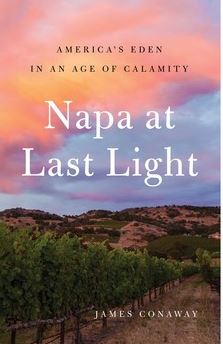Book Review: James Conaway on the Napa Valley Wine Wars
 James Conaway, Napa at Last Light: America’s Eden in an Age of Calamity (Simon & Schuster, March 2018).
James Conaway, Napa at Last Light: America’s Eden in an Age of Calamity (Simon & Schuster, March 2018).
Hegel wrote that the Owl of Minerva only takes flight at dusk, suggesting that wisdom (the owl) finally awakes when the day is nearly done and the opportunity to benefit from insight has almost passed. It is a sad thought — I hope that Hegel is wrong — but it captures pretty well the gist of this new book by James Conaway, who has been writing about the Napa Valley for many years.
Conaway’s new book presents a series of vignettes and profiles that collective capture the ongoing wine war in the Napa Valley. Conaway is not a neutral observer in this battle, so this is a tale of white hats and black hats.
The White Hats include Andy Beckstoffer, Volker Eislele, and Randy Dunn, leaders in movements to preserve Napa’s farming and environmental heritage. The Black Hats include Mike Davis, Jean Charles Boisset, and especially Kathryn and Craig Hall, who have told their side of the wine wars story in their book A Perfect Score.
Reading Conaway’s book about what’s wrong with the Napa Valley made me sad because it reminds me about something that is wrong with society today. The Napa Valley of Conaway’s book is full of people with their backs to the wall, angry, suspicious, and unwilling to bend or compromise. Reminds me of any number of issues in society today (guns and immigration, for example).
There doesn’t seem be much room for meaningful dialogue. Sometimes it seems like there isn’t even a common language, much less common values or goals. Gridlock prevails: movement is slowed or stifled, but threats remain.
Only at the very end of the book — dusk, I suppose, or last light — does Conaway give a sense that there might be some coming together, working together. Hope it is not too late. But recent news is not encouraging.
Pressures continue to grow. Last week, for example, the Napa Country Board of Supervisors voted to put an initiative on the June ballot that would shut off development in certain areas. Pro and con forces seem to be prepared for a serious fight over the future. Meanwhile an interview with James Conaway suggests that he’s given up hope. Too little, too late.
I learned a lot about the Napa Valley, wine wars, and the White Hat and Black Hat combatants from this book, but I admit to being disappointed. Conaway takes a strong stand with his White Hat friends and his anger and outrage come through clearly. But I wonder what the conflict looks like from the perspective those who are in the middle, trying to balance interests and reconcile development and environment before the last light is gone? That’s a book that I would like to read.
Not that there aren’t glimpses here of what a working consensus might look like. I was especially intrigued by the sixteenth chapter, which gives an account of how John Williams of Frogs Leap Winery led a successful movement to restore a stretch of the Napa River. Water, Conaway suggests, is at the root of all conflict in Napa. Rivers both divide and unite. The Williams story shows that it is at least sometimes possible to find common ground.
Building that common ground where shared values are developed and real progress can be made is important both for Napa and for society in general. Having started with Hegel’s owl, I conclude with William Butler Yeats’ falcon, from “The Second Coming.”
Turning and turning in the widening gyre
The falcon cannot hear the falconer;
Things fall apart; the centre cannot hold;
Mere anarchy is loosed upon the world …
The falcon cannot hear the falconer;
Things fall apart; the centre cannot hold;
Mere anarchy is loosed upon the world …
*


No comments:
Post a Comment